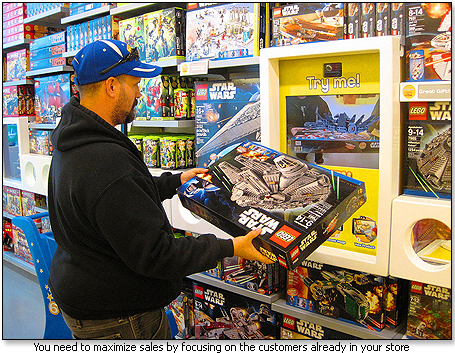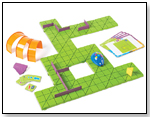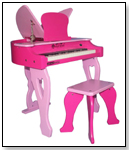|
|
Three Tips to Maximize Retail Sales In some ways, brick and mortar retailers have a finite client base. After all, there are only so many people who can walk into the store on a given day. While marketing can certainly impact that number, your focus can’t be just about attracting new customers. In fact, if you’ve felt meeting your retail sales projections depends solely on the number of shoppers who show up at your door, then you’re leaving a lot of money on the table. Why? Because you probably aren’t maximizing the shoppers who already come into your store. Photo credit: Intel Free Press You’re probably not consistently moving them from a browser to a customer who purchases from you that day. You’re probably not consistently suggestively selling additional products your customers could use but are never shown. Your staff have created a culture in your store of price selling – what’ s on sale, what’s cheapest, and even I’m not trying to sell you. When customers leave with only one item and not with everything they need, a competitor gets their additional business and a chance to make a loyal customer out of one who should have stayed yours. Make no mistake, the stakes are high when a browser walks out without purchasing anything or with only purchasing one item. In short, you’re settling for crumbs when you could have the whole feast. The best approach must capitalize on the visitors who do enter your store - whether it’s twenty or two hundred. Routinely building higher per-ticket sales is a win-win. Even if you get fewer shoppers on slow days or during seasonal downturns, you can still meet your sales goals. During busier times, those higher per-ticket averages directly boost your bottom line. So you might be asking, how do you improve per-ticket averages and increase overall retail sales? Glad you asked… The best way is with staff training that cultivates an atmosphere of value selling. Your salespeople need to be constantly aware of how to sell the value of a single product over the price of the product while looking for ways to enhance that value with additional products. Not only will this lead to more up-sells and add-ons, but it will also help eliminate the need for markdowns to move higher value items. Here are three tips for your salespeople to focus on to increase your retail sales: 1) Building Rapport. Exceptional shopping experiences begin with exceptional employee skills. Your staff needs to know how to engage people from all walks of life in a genuine manner. That means getting out from behind the counter because they want to, not because you have to tell them. Those employees must be able to listen to why the customer walked through your doors today, identify their motivators to buy, and link all of your products in a way that encourages them to buy. When they build rapport and connect with their customers, it will keep customers from browsing for better deals on their smartphones while standing in your store. It will also lay the groundwork for a true relationship where each looks forward to seeing the other again. That also makes it easier for the salesperson to suggest add-ons because they are seen as a human being, a trusted adviser rather than a nameless clerk. 2) Value Selling. Value selling is the foundation of increasing retail sales. It’s easy to mark down items or steer customers toward the cheapest option. Heck, that’s 90% of retail help these days. However, markdowns are bad for profit, and the cheapest option is rarely the best option for the customer. With the proper understanding of the premium products they’re selling, salespeople can keep the conversation focused on the long-term value those products offer. Once customers understand that there truly are differences in quality from good to better to best, they’ll be more understanding of the price differences between those levels. A good tip is to teach them the differences in your most popular SKUS and then have them use the Feel, Felt, Found Method and say, “I used to feel that way too about the price of this item. I felt it was too much. That was until I found out how much (better made, easier to use, quicker, etc.) it was over the others.” Having established the value of the product in the customer’s mind, it’s easier for the salesperson to then segue into a conversation about add-ons. 3. Add-Ons. Salespeople who have an in-depth knowledge of the products they sell should also have a clear understanding of the items that complement those products. If they work in electronics, they know that even the best 4K television only offers limited sound quality. That can lead directly into a conversation about sound bars or surround-sound systems. They’ll know that a beautiful dress is not, by itself, an outfit; that a camera needs a lot of accessories to make it truly an artistic device. The customers leave with products that exceed their initial expectations, and the salesperson gains higher per-ticket sales. To do this effectively, your salespeople need to see the full picture when it comes to their product lines, more-so than the product features. For even if they don’t know the specifics of an add-on but understand the concept of what it does, they’ll be able to create additional value for their customer and not settle for clerking a single item. Where to Begin? The skills and knowledge necessary to increase retail sales all start with the right training program. A well-conceived training program will teach all of these techniques while also instilling an attitude geared toward creating an exceptional customer shopping experience. When they are exceptional, those experiences build a foundation for higher per-ticket sales, repeat customers, and increased retail sales.  Writer's Bio: Bob Phibbs is the Retail Doctor®, a best-selling author and speaker who has helped thousands of independent businesses compete. His new book, The Retail Doctor’s Guide to Growing Your Business has received praise from both Inc. magazine and USA Today and can be found at your local bookstore or ordered at http://www.retaildoc.com/guide. He and his work have been featured in the New York Times, the Wall Street Journal and Entrepreneur magazine. Questions? Contact Bob at info@retaildoc.com. This article was reprinted with permission of the author, Bob Phibbs, aka The Retail Doctor®. Read more articles by this author Writer's Bio: Bob Phibbs is the Retail Doctor®, a best-selling author and speaker who has helped thousands of independent businesses compete. His new book, The Retail Doctor’s Guide to Growing Your Business has received praise from both Inc. magazine and USA Today and can be found at your local bookstore or ordered at http://www.retaildoc.com/guide. He and his work have been featured in the New York Times, the Wall Street Journal and Entrepreneur magazine. Questions? Contact Bob at info@retaildoc.com. This article was reprinted with permission of the author, Bob Phibbs, aka The Retail Doctor®. Read more articles by this author |
| ||||||||||||||||||||||||||||||||
Disclaimer Privacy Policy Career Opportunities
Use of this site constitutes acceptance of our Terms of Use.
© Copyright 2025 PlayZak®, a division of ToyDirectory.com®, Inc.




